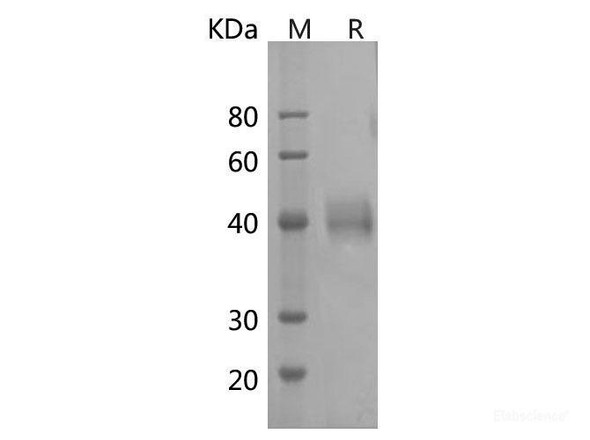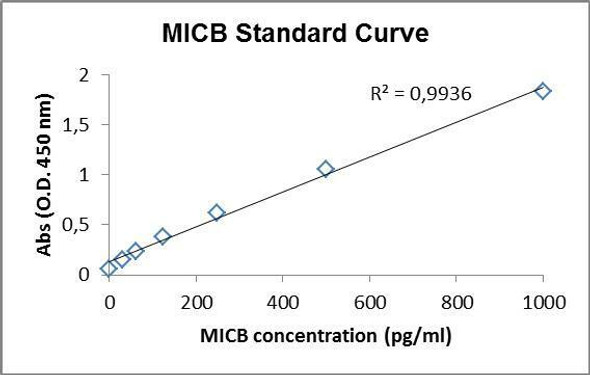Description
| Product Name: | Human MICB Recombinant Protein |
| Product Code: | RPPB3973 |
| Size: | 10µg |
| Species: | Human |
| Target: | MICB |
| Synonyms: | MHC class I polypeptide-related sequence B, MIC-B, MICB, PERB11.2. |
| Source: | Escherichia Coli |
| Physical Appearance: | Sterile Filtered White lyophilized (freeze-dried) powder. |
| Formulation: | Lyophilized from a concentrated (1mg/ml) solution containing no additives. |
| Solubility: | It is recommended to reconstitute the lyophilized MICB in sterile 18M?-cm H2O not less than 100�g/ml, which can then be further diluted to other aqueous solutions. |
| Stability: | Lyophilized MICB although stable at room temperature for 3 weeks, should be stored desiccated below -18°C. Upon reconstitution MICB should be stored at 4°C between 2-7 days and for future use below -18°C.For long term storage it is recommended to add a carrier protein (0.1% HSA or BSA).Please prevent freeze-thaw cycles. |
| Purity: | Greater than 95.0% as determined by(a) Analysis by RP-HPLC.(b) Analysis by SDS-PAGE. |
| Biological Activity: | Measured by its ability to bind MICB antibody in ELISA. |
MICB (MHC class I chain-related gene B) is a transmembrane glycoprotein that functions as a ligand for human NKG2D type II receptor. A closely related protein, MICA, shares 85% amino acid identity with MICB. These 2 proteins are distantly related to the MHC class I proteins. MICA and MICB (MICA/B) possess three extracellular immunoglobulin-like domains, but have no capacity to bind peptide or interact with B2-microglobulin. The genes encoding MICA/B are found within the major histocompatibility complex on human chromosome 6. The MICB locus is polymorphic with more than 15 recognized human alleles. MICA/B are minimally expressed on normal cells, but are frequently expressed on epithelial tumors and can be induced by bacterial and viral infections.
MICB Human Recombinant produced in E.Coli is a single, non-glycosylated polypeptide chain containing 326 amino acids and having a molecular mass of 37kDa. The sequence contains the extracellular domain of the mature human MICB (amino acid residues Ala23 � Tyr312). The MICB is purified by proprietary chromatographic techniques.
| UniProt Protein Function: | MICB: Seems to have no role in antigen presentation. Acts as a stress-induced self-antigen that is recognized by gamma delta T cells. Ligand for the KLRK1/NKG2D receptor. Binding to KLRK1 leads to cell lysis. Genetic variations in MICA are a cause of susceptibility to rheumatoid arthritis (RA). It is a systemic inflammatory disease with autoimmune features and a complex genetic component. It primarily affects the joints and is characterized by inflammatory changes in the synovial membranes and articular structures, widespread fibrinoid degeneration of the collagen fibers in mesenchymal tissues, and by atrophy and rarefaction of bony structures. The MICB*004 allele is associated with rheumatoid arthritis. Genetic variation in MICB is associated with cytomegalovirus and herpes simplex virus I seropositivity and this may be associated with schizophrenia risk. Belongs to the MHC class I family. MIC subfamily. 3 isoforms of the human protein are produced by alternative splicing. |
| UniProt Protein Details: | Protein type:Membrane protein, integral Chromosomal Location of Human Ortholog: 6p21.3 Cellular Component: cell surface; plasma membrane; integral to membrane Molecular Function:beta-2-microglobulin binding; antigen binding; natural killer cell lectin-like receptor binding Biological Process: antigen processing and presentation; regulation of immune response; response to retinoic acid; viral reproduction; response to heat; natural killer cell mediated cytotoxicity; cytolysis; immune response-activating cell surface receptor signaling pathway; response to oxidative stress; negative regulation of defense response to virus by host; gamma-delta T cell activation; T cell mediated cytotoxicity |
| NCBI Summary: | This gene encodes a heavily glycosylated protein which is a ligand for the NKG2D type II receptor. Binding of the ligand activates the cytolytic response of natural killer (NK) cells, CD8 alphabeta T cells, and gammadelta T cells which express the receptor. This protein is stress-induced and is similar to MHC class I molecules; however, it does not associate with beta-2-microglobulin or bind peptides. Alternative splicing results in multiple transcript variants. [provided by RefSeq, Jan 2014] |
| UniProt Code: | Q29980 |
| NCBI GenInfo Identifier: | 74706857 |
| NCBI Gene ID: | 4277 |
| NCBI Accession: | Q29980.1 |
| UniProt Secondary Accession: | Q29980,O14499, O14500, O19798, O19799, O19800, O19801 O19802, A2AC57, A6NP85, B0UZ10, B2RAK2, |
| UniProt Related Accession: | Q29980 |
| Molecular Weight: | 4,287 Da |
| NCBI Full Name: | MHC class I polypeptide-related sequence B |
| NCBI Synonym Full Names: | MHC class I polypeptide-related sequence B |
| NCBI Official Symbol: | MICB�� |
| NCBI Official Synonym Symbols: | PERB11.2�� |
| NCBI Protein Information: | MHC class I polypeptide-related sequence B; MHC class I mic-B antigen; stress inducible class I homolog; MICB {ECO:0000312|EMBL:CAA62823.1}; MHC class I chain-related protein B; MHC class I-like molecule PERB11.2-IMX |
| UniProt Protein Name: | MHC class I polypeptide-related sequence B |
| Protein Family: | MHC class I polypeptide-related sequence |
| UniProt Gene Name: | MICB�� |
| UniProt Entry Name: | MICB_HUMAN |






